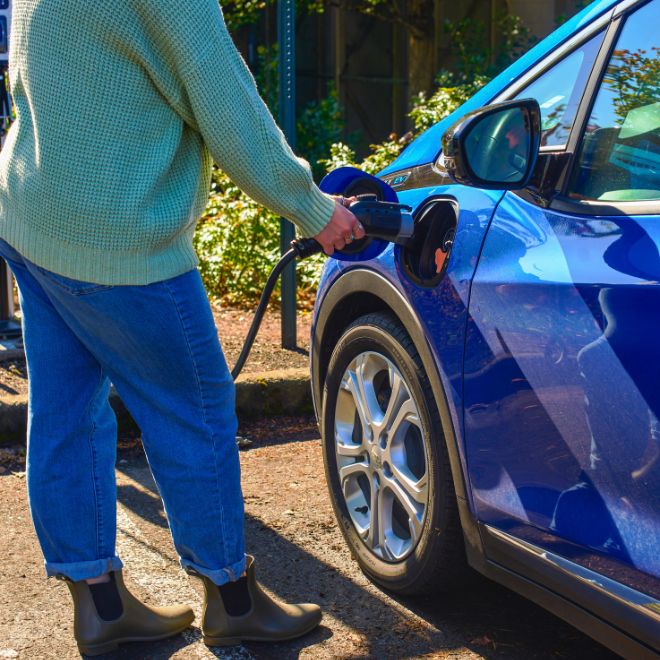Chevy Bolt Charging Options
With multiple charging options available, you can power up a Chevy Bolt almost anywhere. That said, selecting the correct level of charge is essential. Let’s break down your options in more detail.
Level 1 (Standard Outlet)
Level 1 charging is the slowest option. It requires no special equipment beyond the portable charger that comes with your Bolt and a wall outlet. However, a full charge can take over 48 hours, so it’s only practical for extremely low daily mileage or emergency use—and even then, probably only in a pinch.
Level 2 (Home & Public)
Level 2 offers significantly faster charging. It’s what most EV drivers rely on for everyday home and public charging. With a home charger, you can fully charge your Bolt overnight in a home garage. Or if you live in an apartment or multifamily building, you can use a commercial Level 2 charger like the Blink Series 7 ISO to charge in your surface lot or parking garage. Alternatively, there are thousands of public Level 2 stations located in convenient spaces nationwide.
DC Fast Charging (Level 3)
DC fast charging bypasses your Bolt’s onboard charger and sends power directly to the battery, making it ideal for road trips, long drives, or quick top-ups when you’re short on time. Generally speaking, you can expect to charge your Chevy Bolt in under an hour when using a Blink DC fast charger, although this time may vary depending on your EV's capabilities and the charger’s power level.
Note: Most newer Chevy Bolt models include DC fast charging capability, but it was optional on some earlier model years (especially pre-2021). Ensure your Bolt is equipped with a CCS port before attempting to use a DC fast charger. Note that while CCS is the standard for DCFC, a NACS adapter is required to charge at a NACS charger.
How to Charge Your Chevy Bolt at Home
Home is by far the easiest and most convenient place to charge, as Level 2 charging can fully top off your Bolt in 7–10 hours, making overnight charging practical for most drivers. However, Level 1 charging can take over 48 hours for a full charge.
To charge your Chevy Bolt at home, you’ll need a charging cable and a matching power outlet. Once again, your Bolt comes with a Level 1 portable charger, best used in a pinch or for emergencies. When using a charging cable, park as close as possible to the wall outlet and avoid draping the cable across a walkway, as this can create a tripping hazard.
For Level 2 home charging, you’ll need a dedicated 240-volt circuit with either a hardwired charger or a compatible NEMA 14-50 wall outlet. In most cases, adding these features is a straightforward task for a licensed electrician, who will assess your electrical panel, install the new circuit, and ensure everything complies with local codes and safety standards.
If your multifamily community has commercial chargers, such as the Blink Series 7 ISO or Series 8 ISO, ask your property manager for instructions on accessing the charging stations. Depending on your community, you might receive discounted rates as a resident amenity.
How to Charge a Chevy Bolt at a Charging Station
How do you charge a Chevy Bolt if you travel a lot or don’t have access to a home charger? That’s where public charging comes in.
Finding Charging Stations
Most Chevy Bolts have built-in navigation to nearby chargers, although many drivers prefer using websites or apps for real-time data. Download the Blink Charging app to view station availability, connector types, and charging speeds. You can also use web platforms like Google Maps or PlugShare.
Using DC Fast Charging
Not sure how it works? Here’s how to use a Blink DC fast charger with your Chevy Bolt:



